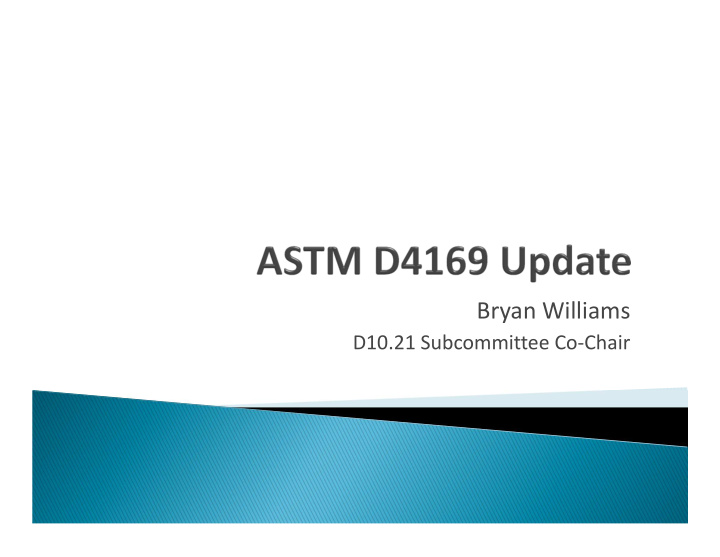



Bryan Williams D10.21 Subcommittee Co ‐ Chair
AGENDA: ASTM History “The Future of D4169” (2011 Workshop) ASTM D4169 ‐ 16 Revisions What’s Next?
PRE ‐ 1970 Prior to 1970, each shipper who did any testing had their own criteria for a successful package. Corporate Test Specifications (GE and Kodak) National Safe Transit Association (NSTA) has Tests 1 and 1A dating back to 1945.
1970s 1971 – ISO package testing subcommittee begins work on package performance standard 1973 – D10 task group formed to develop package performance specifications 1974 – ISO draft proposal circulated; some of its basic structure adopted by D10 task group
1970s 1974 ‐ 1977 – lots of lively debate… 1977 – US Forest Products Lab (FPL) sponsors research 1979 – General Technical Report FPL22 – this report provides basis for test intensities, etc. in D4169. 1979 – D10 decides to publish “D4169” concept as proposal (marketing effort)
1980s 1981 – After 9 years of development… the 7 th draft of proposal approved by D10. 1982 – D4169 published in August. 1984 – D4003 test method added (Schedule H Rail Switching)
1980s 1986 – Replaced D685 with D4332 for Conditioning 1988 ‐ 1992 – Several revisions published : • Added DC 15,16, and 17 for import/export • Added military package testing and DC18 • Added Element J Environmental Hazard • Revised Element D Vehicle Stacking • Revised Elements E & G on vibration (D4728 random vibration)
1990s 1994 – Added criteria for second series of drops in Element A 1996 – Added D5277 and D5487 impact test options for Elements A and H. 1998 – Changed Elements to Schedules (A thru H); revised listing of Schedules 1998 – Added Air PSDs to Schedules D & E
2000s 2004 – Added Schedule I Low Pressure (High Altitude) hazard 2008 – Multiple Revisions: • Small package express removed from DC3 • Military ‐ only test requirements moved to A1 Annex • Schedule H water spray temperatures significantly increased • Schedule J added
Fall Meeting – 2011 ASTM Committee D10 Workshop (Tampa) Presentations given on review of Compression, Vibration, Rail Switching, and Environmental Hazard Test Elements.
Schedule B, C – Stacking Recommended Review Topics: • Test Level Factors (F) • Average Shipping Density Factor (10 lb./ft3) • Note 3 (value of H)
Schedule D, E – Vibration Overview of origins of vehicle profiles (FPL22) Review of other Industry and corporate vibration profiles “Kickoff” for Random Vibration Task Group which lead to 2016 updates
Schedule G – Rail Switching Recommendation to change Schedule G so test procedures align with Transportation Technology Center approach: • Four impacts (rotate 180° for fourth impact) • Two Assurance Levels
Schedule G – Rail Switching
Schedule E – Vehicle Vibration (Truck) Distribution environment measurement more cost effective, common today Truck data spectral shape, intensity didn’t correlate well Developments in testing technique improvements (varied intensity)
Schedule E – Vehicle Vibration (Truck) “Revision Awareness” Campaign ◦ Eric Joneson, Larry Anderson presentations ASTM D4169 Truck Profile Update Rationale Balloted Rationale first to address concerns before submitting revisions for approval.
Rationale Document
Rationale Document
Rationale Document Procedure Guidance added September 2016 ◦ Test Procedure explanation ◦ PSD Plot Comparisons ◦ PSD Intensity Comparison
Added SUMMARY OF CHANGES section
Conditioning (Section 6) Proposed revisions to Section 6 (D10.21 (17.03)) ◦ Clarification / addition of recording temperature and humidity with the time out of conditioning between test schedules ◦ Addition of F2825 as a reference document ◦ Addition to Section 18 (Reporting)
Conditioning (Section 6) D10.21 Ballot closed September 29 ◦ 3 Negative Votes, 5 Comments ◦ Technical Contact (Jan Gates) currently working to address and resolve negatives and comments.
Schedule J – Concentrated Impact For certain package types, lab failures do not correlate well with field results. Survey conducted to gather D10 feedback on Schedule J test procedure.
Schedule J – Concentrated Impact “ Eliminate the test schedule. Remove it from D4169…” “Move to design testing instead of distribution testing…” “Does Schedule J even correlate to damage seen in the field?”
Schedule J – Concentrated Impact Recommended Revisions: ◦ Recommended test for elongated & flat packages ◦ Optional design test for all other corrugated shipper sizes ◦ Optional test for stretch wrapped pallet loads ◦ Eliminate (275#) exclusion criteria for corrugated fiberboard
Schedule E – Vehicle Vibration Rail vibration review ◦ AAR planning data project (intermodal rail). ◦ ASTM would like to wait for that data to be available before further reviewing the rail dynamics.
Rail Vibration review Spectral shape, intensity, time Single axis vs. multi ‐ axis Different Rail environments
Rail Vibration review Spectral shape, intensity, time Single axis vs. multi ‐ axis Different Rail environments
Schedule E – Vehicle Vibration Air vibration review ◦ What does “Air vibration” include? ◦ Some data, research available. Need more!
Air Vibration review
Air Vibration review Spectral shape: ◦ Do we combine or separate “ground” and “air”? Intensity / Time: ◦ Dependent on combining or separating environments Single or Multi ‐ axis: ◦ Aircraft move in 6DOF, ground vehicle move predominantly in 3DOF
Air Vibration review Draft Air Vibration Rationale document Historical data, company data, new data Goal to have Rationale completed before: Spring 2018 meetings
Not Too Distant Future…maybe… New DCs (E ‐ commerce) Combined Environments Multi ‐ Axis Vibration Load Stability
Bryan Williams D10.21 Subcommittee Co ‐ Chair
Recommend
More recommend